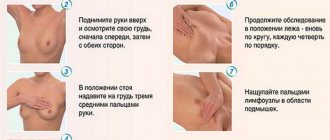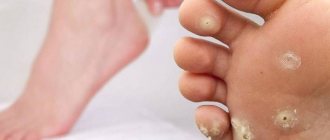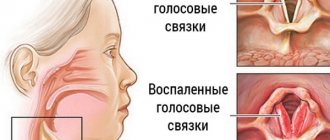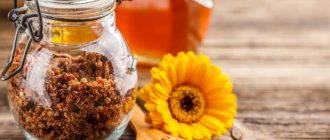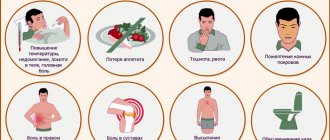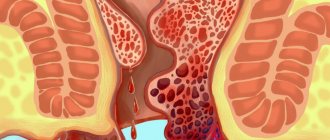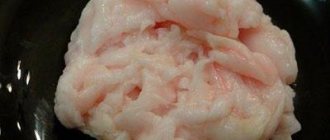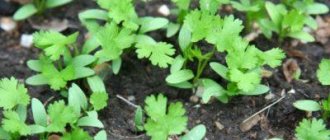Effective treatment of lymphadenitis at home.
Lymph nodes perform a protective function in the human body; normally they are painless and cannot be palpated, they are not visible externally. With lymphadenitis, they become inflamed and increase in size, which often signals the presence of some unfavorable process in the body. Treatment of lymphadenitis with folk remedies should be aimed at both eliminating local manifestations and combating the cause of the disease.
Depending on the nature of its occurrence, lymphadenitis may differ in some of its symptoms, as well as in the degree of their severity. Therefore, it is very important to understand the cause of such inflammation and, based on this, choose treatment options. This approach will help achieve lasting improvement in a person’s condition and a speedy recovery.
Why does lymphadenitis occur?
Despite the fact that there can be many reasons for inflammation of the lymph nodes, there are three main factors that lead to lymphadenitis:
- immune process;
- infection;
- tumor lesion.
Immune processes leading to lymphadenitis include inflammation of the joints, systemic connective tissue diseases, and the body’s reactions to certain medications. Among infections, lymphadenitis can most often be caused by those bacteria that lead to purulent inflammation, as well as many viruses and some pathogenic fungi. With the development of tumors in the body, the lymph nodes enlarge either due to the development of the tumor itself from the tissues of the lymphatic system, or as a result of the influence of metastases.
Most often, the lymph nodes become inflamed in the area of the body where the pathological process takes place. This is due to the fact that, first of all, it is here that the outflow of lymph is disrupted, and the lymph nodes cannot function normally. But sometimes there are forms of lymphadenitis in which the lesions spread to distant lymph nodes, sometimes they are inflamed throughout the body. This painful condition is called generalized (general) lymphadenopathy. Therefore, when a painful area is detected, it is important to check the remaining areas of the lymph nodes for their integrity and the presence of inflammation.
The most common form of the disease that many people encounter in their lives is submandibular lymphadenitis. This is due to the fact that it often occurs against the background of common diseases, such as ARVI, herpes, and the presence of diseased teeth in the oral cavity. Therefore, inflammation of the lymph nodes in this area is in first place in frequency.
Quickly cure lymph nodes. How to treat lymph nodes in the neck in an adult
Remember that only the attending physician can tell you in detail how to treat the lymph nodes in the neck! Self-medication is fraught with consequences. The information below is for informational purposes only and is not a substitute for medical advice.
Inflammation of the lymph nodes in the neck is called lymphadenitis. Treatment of this disease should be aimed, first of all, at eliminating the cause of its occurrence, since lymphadenitis is not an independent disease, but only a symptom of some other ailment. Next, we will consider how to treat cervical lymph nodes depending on the cause of lymphadenitis.
Drug therapy
Most often, diseases of the lymph nodes are associated with the entry of infectious agents into the body that cause bacterial, viral or fungal diseases. Therefore, in order to eliminate the inflammatory process, drugs are prescribed that “kill” the infection:
- Antibiotics. Enlarged lymph nodes in the neck in most cases are caused by bacterial infections (sore throat, tonsillitis), so antibiotic therapy is prescribed for treatment. If necessary, a swab is taken from the throat or nose to determine the type of pathogen, and depending on its type, tablets are selected. But more often, complex broad-spectrum antibiotics are prescribed, to which most aerobic and anaerobic microorganisms are sensitive. These are penicillins and their derivatives, Ciproflaxacin, Summed, Amoxicillin, Flemoxin Solutab, Bicillin, etc.
- Antiviral drugs are effective when the cervical lymph nodes are enlarged due to a viral infection. This occurs mainly during seasonal epidemics in the cold season. In the case of ARVI, acute respiratory infections, influenza A and B viruses, the most effective drugs are Anaferon, Viferon, Kagocel, Ingavirin, Arbidol. Antibiotics are not prescribed in case of a viral infection, either at all, or only when a bacterial infection occurs.
- Antifungal agents are effective in cases of fungus in the mouth. This phenomenon is accompanied by a sore throat, white plaque on the tonsils and tongue, and inflammation of the cervical lymph nodes. The fungus can enter through common areas (for example, in a swimming pool), as well as after taking antibiotics. The most effective antifungal drugs are Nystatin, Flucostat, Fluconazole.
- Anti-inflammatory drugs, which are used in the form of tablets for oral administration, lozenges, sprays, solutions for treating a sore throat. These products contain herbal anti-inflammatory components, antibiotics, antiviral components, as well as painkillers and anesthetics. Of the tablets for the treatment of neck lymph nodes, the most popular are Grammidin, Lizobakt, Immudon, Strepsils, Faringosept. Ingalipt, Kameton, Hexoral, Stopangin, etc. are prescribed in the form of sprays. A sore throat, which is the cause of lymphadenitis, can be treated with Lugol's solution, Chlorphyllipt.
Symptoms of lymphadenitis
The manifestations of this disease differ depending on its course. Lymphadenitis can be acute or chronic. Symptoms of acute lymphadenitis are pronounced and usually manifest themselves as follows:
- soreness of the lymph nodes;
- tissue swelling;
- increase in local temperature of the inflamed area;
- chills;
- body aches;
- increase in general body temperature.
With timely assistance to a person, these unpleasant manifestations of the disease can be quickly eliminated and this can be done at home without much expense or labor. The main thing is not to miss the moment when the disease has not yet progressed and is in the initial stage of development.
In severe cases, symptoms can rapidly increase and worsen. This is usually observed with purulent lymphadenitis, which is very dangerous. Areas of tissue become purplish or red, they are hot to the touch, their pain intensifies, and the person experiences an increase in body temperature to 39–40 °C. This type of development of lymphadenitis is rare, but it definitely requires emergency care to avoid serious complications and consequences.
Local remedies for the treatment of lymphadenitis
To combat local manifestations of lymphadenitis, ointments and compresses are especially popular among traditional medicine. They help relieve inflammation and relieve pain. Here are several recipes for ointments and solutions for compresses that are used in the treatment of inflamed lymph nodes:
Ointment based on badger fat. To prepare it, you need to add 3 tbsp to the base (badger fat) melted in a water bath. l. herbs For 4 hours, this mixture must be kept heated in a water bath at a constant temperature, after which it must be strained and cooled. You need to apply the ointment to the lymph nodes 3 times a day.- Mint and dandelion herb compresses. Grind fresh mint leaves to release the juice from the plant. In a separate bowl, grind the dandelion grass in the same way. Alternately, at intervals of two hours, compresses from these juices should be applied to the diseased lymph nodes. It is important to secure the compress well on top with a bandage or bandage so that the active substances penetrate into the inflamed tissue. Such compresses can be done 2 times a day each.
- Olive oil based mixture. In 1 tbsp. l. olive oil, add a few drops of lavender essential oil or tea tree oil. This mixture can be lubricated with lymph nodes or used for compresses. This remedy is especially effective for submandibular lymphadenitis caused by respiratory diseases, because these essential oils have an antibacterial and anti-inflammatory effect.
An important condition for the use of local traditional medicine is to use them only in chilled form. In case of lymphadenitis, under no circumstances should the lymph nodes be warmed, actively rubbed or massaged. All this can provoke a worsening of the condition and lead to a more acute development of the process.
Treatment of lymph nodes with compresses
Enlarged lymph nodes can be caused by the development of a number of diseases. Many people experience slight swelling of the nodes even with a common cold. This condition is normal and indicates that the body is fighting infection, and increased production of lymphocytes occurs in the node itself.
But what to do if the lymph nodes are very enlarged and hurt? In such cases, you should contact a specialist as soon as possible. To temporarily alleviate the patient's condition, you can apply a medicinal compress to the affected area.
The compress is recommended to be used to relieve unpleasant symptoms - pain, swelling
In folk medicine, there are several effective compress recipes that can alleviate the patient’s condition. Their use allows you to achieve the following results:
- reduce pain;
- relieve swelling and redness of the skin;
- prevent further spread of the pathological process.
You should not attempt to treat enlarged lymph nodes with compresses. Such a measure can only be used to temporarily alleviate the patient’s condition. In the future, he should be prescribed professional treatment.
Any enlargement of the lymph nodes indicates an infectious lesion in any part of the body or the development of a tumor. Each node group is responsible for its own department. For example, inguinal formations become inflamed with the development of a genital infection, and cervical ones may indicate the development of a sore throat. Therefore, to eliminate the inflammatory process, the root cause of the disease should be dealt with.
In the absence of severe symptoms, the underlying disease can only be determined through instrumental and laboratory diagnostics. Therefore, if you have enlarged lymph nodes, you should never self-medicate. You should contact a specialist as soon as possible.
Indications
A compress cannot be placed on a lymph node in all cases. In some situations, such actions may not bring the desired results or even harm the patient’s health.
Compresses can be applied in the following cases:
- If the lymph nodes have increased in size. The normal size of the node varies from 0.1 to 0.5 cm. However, it should not protrude above the level of the skin in the form of a tubercle. Most lymph nodes cannot be palpated due to their small size. If the formation has increased to 1 cm in diameter, then it can be easily palpated and become visually noticeable. Compresses can be applied to lymph nodes whose size does not exceed one and a half centimeters.
- Soft consistency. Normally, lymph nodes should be soft and elastic. When pressed, they roll freely under the skin. Slight hardening caused by the development of the inflammatory process is allowed.
- Lack of adhesion to surrounding tissues. The node must have clear boundaries.
- Uniform structure. The node retains its normal outline and structure.
- Slight redness of the skin is allowed. The skin over the lymph node can be either light or slightly reddish.
- Moderate pain. It can be observed both when pressing on the affected area, and it can be present constantly.
Contraindications to applying compresses
If there is severe pain in the lymph nodes, you should avoid compresses, as this can lead to deterioration of health.
In some cases, the use of compresses on the lymph nodes is undesirable and can lead to the development of adverse consequences. Experts categorically do not recommend using compresses in the following cases:
- The lymph node has reached a significant size. In some cases, such formations can increase to 5 or even 10 cm in diameter. Most often we are talking about a purulent form of lymphadenitis, in which the use of compresses and any local influences is prohibited.
- Blueness and darkening of the skin. If the skin around the node turns dark blue, this is a reason to immediately consult a doctor.
- Severe pain. They can appear either at rest or occur when touching an inflamed area.
- The structure of the node is uneven, which is revealed by light palpation or visually. As a rule, lymph nodes that are at this stage of the inflammatory process harden and practically do not budge during palpation.
- The node is fused to the surrounding tissues. This indicates a significant development of the inflammatory process, and therefore exposure in the form of a compress can lead to the development of complications.
Experts categorically do not recommend the use of hot compresses for any type of inflammation of the lymph nodes. Such actions can lead to a deterioration in the patient’s general condition and the development of complications of the underlying disease.
Recommendations from experts
Due to the vagueness of the symptoms of lymphadenitis, most experts categorically do not recommend self-medication of the disease, even as part of first aid. Something as harmless as a compress can cause a number of unpleasant consequences.
If the patient nevertheless decides to use compresses to treat the lymph nodes, then they can be used only in the first stages of the development of the pathology. It should be remembered that a compress does not cure the disease. Even if, as a result of such manipulations, the symptoms of the disease have practically disappeared, this is only a temporary effect, indicating that the process has become chronic.
Let's consider the general recommendations of specialists for installing compresses on lymph nodes:
- Warming compresses should not be used. Heating the nodes is strictly prohibited.
- When installing a compress at night, do not use tight bandages - damaged tissues should not be squeezed.
- After removing the compress, the skin should be washed with plenty of water.
- During the day, keep the compress on the affected area for no more than half an hour.
Some categories of patients are allowed to be treated with compresses only after visiting a doctor. These include:
- elderly people;
- pregnant women;
- children under 12 years of age;
- patients with HIV.
For infection caused by the immunodeficiency virus, symptomatic treatment is considered inappropriate, since local treatment of the nodes will not bring any result.
General herbal medicine
Since lymphadenitis often indicates disturbances in the body’s immune system, the use of infusions and herbal extracts should have a general strengthening and anti-inflammatory effect. Thus, taking tinctures of Eleutherococcus and Echinacea strengthens the body’s immune system and thereby helps to quickly get rid of the symptoms of lymphadenitis. They should be used by diluting 30 drops of the drug per 100 ml of water, and drink half an hour before meals three times a day.
Hazel bark also has the ability to reduce the manifestations of lymphadenitis. To prepare the infusion, you need to take ¼ cup of hazel bark and leaves and pour 0.5 liters of boiling water over them. Leave this solution in a water bath for an hour. Take this decoction orally before each meal, but no more than 4 times a day.
When treating lymphadenitis with traditional methods, you need to monitor the dynamics of the disease. For uncomplicated variants of the development of the disease, folk remedies have a quick and successful effect. Their use allows you to avoid causing unnecessary toxic effects to an already weakened body, which are characteristic of many synthetic drugs. But if there are no signs of recovery or worsening of the condition, you should consult a doctor to adjust the treatment plan.
Lymphadenitis: treatment at home with folk remedies.
Compresses for inflammation of the lymph nodes in the neck. Lymph nodes in the neck - location, photo
The following types of lymph nodes are distinguished (depending on the place on the neck where they are located):
- anterior cervical;
- posterior cervical;
- submandibular;
- chin;
- ear;
- occipital
Causes of inflammation of the lymph nodes in the neck
What and why do the lymph nodes in the neck become inflamed? This question comes up quite often. There are many, many reasons. As a rule, these are systemic (general) diseases or diseases of certain organs.
1. Infectious diseases of the respiratory system (most often):
The cause of neck lymphadenitis can be determined using the symptoms observed in the patient: nasal congestion, loss of smell, muscle pain, cough, fever, chills and others. 2. Oral infections:
- destruction of dental tissue (caries);
- inflammation of the tongue;
- inflammation of the tooth root;
- inflammation of the gums
3. Common infectious diseases:
4. Autoimmune diseases (when the human body does not perceive its cells and fights them).
- joint damage (arthritis);
- Sjögren's syndrome (chronic inflammation of the lacrimal and salivary glands);
- destruction of connective tissue;
- formation of high-density nodes in organs;
5. Oncological diseases (malignant formations);
6. Impaired immune system (more common in people who suffer from vitamin deficiencies and symptomatic stress, overwork);
7. Allergy (excessive sensitivity to products that may be allergens). It is with chronic allergies that the lymph nodes begin to enlarge.
- Symptoms: rash, swelling in the throat, cough, redness of the skin, vomiting;
- 8. Chronic alcoholism;
- 9. Tissue injuries in the lymph node area;
- 10. Thyroid diseases;
- 11. Failure of metabolism in the body;
Classification of cervical lymphadenitis
- acute lymphadenitis of the neck, which is accompanied by severe pain and redness of the lymph nodes. Since it is not an independent disease, but a symptom, it is not the lymph glands that are treated first, but the disease itself.
It is imperative to provide the patient with assistance before visiting a medical professional: complete rest and lack of physical activity, give him plenty to drink, especially warm drinks (raspberries, chamomile...)
It is important to remember: forget about the need to warm the inflamed lymph nodes, also do not use any warming ointments or massage them, do not apply meshes using iodine. This can only lead to a significant deterioration of the condition.
- chronic cervical lymphadenitis, in which the lymph nodes greatly increase in size, but the pain is insignificant. In some cases it may be completely absent. The optimal solution in this case is to take medications to strengthen the body’s immune function: tincture of ginseng, Rhodiola, Echinacea.
The following types are also distinguished:
- catarrhal, which is characteristic of the onset of infection;
- hyperplastic, which occurs in a later stage. The lymph node in the neck begins to grow rapidly;
- purulent - this is a rather serious stage, as phlegmon may occur (when pus spreads throughout the neck).
Symptoms of inflammation of the lymph nodes in the neck - signs
- The key sign is enlargement of the lymph nodes, their hard structure and elasticity. Sometimes they can become the size of a walnut; patients often say that their lymph nodes in the neck are swollen;
- pain in the area of the inflamed lymph node;
- dizziness may occur;
- increased body temperature;
- pain when swallowing food;
- general body fatigue;
- joint pain…
Diagnosis of cervical lymphadenitis
To prescribe the appropriate treatment for your case, you need to correctly find out the cause, and also consult a doctor so that he can more accurately diagnose you.
As a rule, the following tests are prescribed: blood (general), ultrasound, blood testing for viruses, puncture of enlarged lymph nodes, biopsy...
Inflammation of the lymph nodes in the neck - treatment
So, how to treat inflammation of the lymph nodes in the neck? There are many ways to treat this disease.
These include both traditional drug treatment and home treatment with folk remedies. It is worth knowing about many nuances and contraindications before choosing the method that is needed in a particular case.
Traditional methods of treating lymph node inflammation
How to treat lymph nodes in the neck with medication?
UHF therapy is widely used in medical practice. As many years of experience have shown, it really contributes to the rapid reduction of pronounced symptoms of the disease and a person’s recovery.
Lymphadenitis - treatment at home
First of all, before starting to use alternative medicine, you should agree on the treatment process with your doctor. And also, a disease such as lymphadenitis requires an integrated approach, using a natural remedy or a collection internally and externally, in the form of an ointment or compress.
A popular method of folk treatment is kerosene. In case of inflammation of the lymph nodes, it is recommended to take 1 tablespoon of purified kerosene on an empty stomach every morning, and immediately eat a small slice of bread. Taking fish oil internally and repeatedly lubricating inflamed lymph nodes with it also promotes recovery.
Folk remedies for lymphadenitis based on medicinal plants, and in particular herbal remedies, help well. Here are some effective recipes.
- 6 parts birch leaves;
- 3 parts wormwood herb;
- 2 parts each of oregano, lungwort and St. John's wort;
- 1 part each of thyme, blackhead and toadflax.
Grind the ingredients and mix. Pour two large spoons of the healing mixture into a liter of boiling water and leave for one night; it is better to do this in a thermos. In the morning, filter the infusion and drink throughout the day as tea.
Take everything in equal parts:
Mix all the herbs and brew them with boiling water. After some time, squeeze it out and apply it warm to the inflamed lymph nodes. It is not recommended to keep the herbal compress for more than three hours.
- Collect 100 young pine tips at the end of May;
- Grind and add water in a volume of 2 liters;
- Place on the fire, let it boil and simmer the mixture for two hours;
- Then strain the broth, add another liter of water and a glass of granulated sugar;
- Bring to a boil again and leave to simmer for another 2 hours.
The prepared remedy is taken only once a day, one tablespoon inside.
Lymphadenitis in children, treatment with folk remedies
To alleviate the condition of a sick child, reduce pain and relieve swelling, it is not always possible to use the means that adults use. But even in the case of inflammation of the lymph nodes, traditional medicine has a lot of proven, effective and safe recipes. Let's look at the most popular of them.
Soap compress
- Rub a cloth napkin with baby or laundry soap;
- Apply a napkin with soap to the diseased lymph node and secure with a plaster or bandage;
- At night, cover with compress paper and leave the compress on all night.
Baked onion
- Bake a large onion (including skins) in the oven;
- Cool, peel and puree it;
- Add a teaspoon of birch tar to the onion puree and stir;
- Apply the product to a cloth, apply to the inflamed areas and secure.
- The compress is left for at least two hours.
Walnut compress
- Grind walnut leaves;
- Pour a large spoonful of raw nuts into a glass of water;
- Place on the fire and boil for a few minutes;
- Soak a napkin in the prepared broth and apply it to the diseased lymph node for 15 minutes.
Ordinary white cabbage also quickly relieves swelling and inflammation in the lymph nodes. It is enough to lightly beat a fresh cabbage leaf with a hammer and apply it to the sore spot, fix it. Change sheet as needed.
Treatment of lymphadenitis with folk remedies.
Very often, especially in the initial stage, the disease can be stopped or completely cured using folk remedies and methods of treating lymphadenitis. Here are a few traditional medicine recipes that will definitely help at the right time.
Alcohol and medicinal compresses
To alleviate the patient's condition, special compresses are used for inflammation of the lymph nodes in the neck. For these purposes, medicinal herbs are most often used. One of the most effective plants for such inflammatory processes is celandine. To prepare a compress based on it, you need to thoroughly rinse the herb with clean water. After this, squeeze out the juice and mix it with alcohol in equal proportions.
The solution prepared in this way is used for a compress. Moisten a piece of gauze with warm water, wring it out and soak in the mixture. Then apply to the affected area on the neck, cover with polyethylene and secure with a bandage or a regular scarf. It is best to carry out this procedure before bed.
In some situations, a “winter version” of a compress based on celandine is prepared. To do this, pour 2 tablespoons of herbs into 100-150 grams of water and place on fire. The finished broth should be infused, covered with a warm towel. After this, dilute it with alcohol in equal proportions and use it as in the previous recipe. Such procedures have an excellent warming effect, especially for sore throat.
If certain diseases develop, you cannot use alcohol compresses on the lymph node. Therefore, before using them, it is necessary to coordinate treatment with your doctor.
To prepare the following recipe you will need peppermint leaves. It is necessary to grind them thoroughly and apply the finished pulp onto gauze folded several times. Also use a bandage to secure it.
Inflammation of the lymph nodes can also be treated with another effective method. Melt a small piece of technical rosin, fry the onion in vegetable oil, grate a little laundry soap. Then add all the ingredients to the hot rosin and mix thoroughly. The mixture prepared in this way serves as an excellent warming agent for a night compress on the affected area.
Also often used for treatment is a tincture of purple echinacea, which can be bought in almost every pharmacy. Dilute it with clean water in equal proportions, and use the resulting product as a base for a compress.
It should be understood that inflammation of one lymph node, which is not accompanied by pain and subsequent development, does not yet indicate the presence of a serious anomaly in the body. Most likely, over time he will restore his usual state. Enlargement of several lymph nodes is a more dangerous sign, indicating the presence of a more severe disease.
Vessels
Extravasal Compression of Both Vertebral Arteries: Signs, Surgery
Feb 03, 2021 Kokh V. A.
10168
Vessels
Enlargement of the Jugular Vein in the Neck: Causes of Phlebectasia
Feb 03, 2021 Kokh V. A.
15559
Vessels

